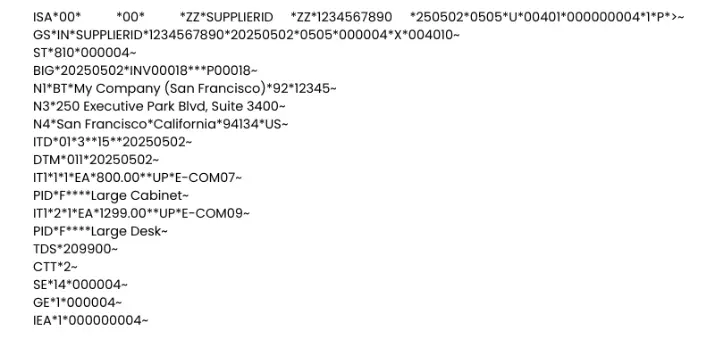EDI-810
Electronic Invoice
What is an EDI 810?
EDI 810 – Electronic Invoice is a digital document exchanged between a seller and a buyer to communicate the details of a completed sale and formally request payment. It replaces traditional paper, PDF, or email invoices and is transmitted electronically via secure protocols like AS2, FTP, or HTTPS.
An EDI 810 Invoice follows the standardized ANSI X12 EDI format defined by the American National Standards Institute (ANSI). It is widely used across industries to streamline accounts receivable processes, reduce manual errors, and accelerate payment cycles. EDI 810 is a versatile and general-purpose electronic invoice applicable across retail, distribution, manufacturing, and logistics.

Key Components of an EDI 810 Invoice
An EDI 810 Invoice mirrors the structure and data of a traditional invoice but in a machine-readable format. The standard document includes:
Invoice Number & Invoice Date
Unique reference identifiers for the transaction.
Seller, Buyer, and Remittance Details
Legal business names, addresses, contact info, and remittance instructions.
Order Line Items
Product SKUs, descriptions, unit prices, quantities ordered and shipped.
Subtotal, Discounts, and Additional Charges
Includes allowances, shipping, handling, or surcharges.
Applicable Taxes
Sales tax, VAT, or other tax identifiers as per compliance.
Total Amount Due
Complete invoice value after calculations.
Payment Terms & Due Dates
Net payment terms (e.g., Net 30), early payment discounts, and due dates.
Accepted Payment Methods
Bank transfer, ACH, wire transfer, or digital payment modes.
How to Use EDI 810?
The EDI 810 Invoice is typically used after a product or service has been delivered. It helps sellers formally request payment while ensuring transaction accuracy and compliance. Here’s how it works in a typical B2B EDI workflow:
1. Seller Sends the EDI 810 Invoice
Once an order has been shipped, the seller (such as a manufacturer, wholesaler, or distributor) generates and sends an EDI 810 Invoice to the buyer. This invoice includes all billing details—products shipped, prices, taxes, and payment terms.
2. Buyer Confirms PO
The buyer's system receives the EDI 810 document and responds with Acknowledgement, confirming successful receipt of the invoice file.
3. Invoice is Verified and Processed
The buyer’s accounting or AP (Accounts Payable) team reviews and validates the invoice. Once confirmed, the invoice is approved and queued for payment processing. We use FTP / SFTP to transfer the document.
4. Buyer Sends EDI 820 (Optional)
The buyer can optionally send back an EDI 820 Payment Order or Remittance Advice, which contains payment confirmation, amount, bank transfer details, and references for reconciliation.
Benefits of EDI 810

Faster Payment Cycles
Automates invoice delivery to speed up billing and improve cash flow.

Greater Accuracy
Eliminates manual data entry errors by transmitting information directly between systems.

Enhanced Data Security
Minimizes disputes caused by price mismatches or outdated product details.

Operational Scalability
Processes high invoice volumes without increasing administrative workload.

Compliance & Audit Readiness
Maintains standardized, traceable digital records for regulatory requirements.

Cost Savings
Reduces paper, printing, postage, and manual labor costs in the invoicing process.
Direct EDI 810 Integration – For Both Suppliers and Customers
At Vraja Technologies, we build seamless EDI 810 solutions for both the supplier (seller) side and the customer (buyer) side. Whether you need to send invoices or receive and process them, our system ensures full compatibility and real-time data flow.
With our deep expertise in Odoo EDI integration, we implement EDI directly between trading partners—without the need for any third-party middleware or service providers. This direct approach not only reduces costs but also increases speed, control, and transparency across your invoicing process. The document gets generated as per the EDI format.
Our end-to-end solution helps you stay compliant, reduce manual intervention, and scale your operations effortlessly—all within your Odoo environment.